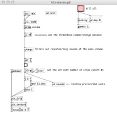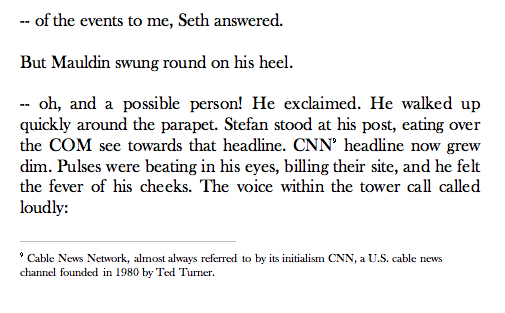Projects from the course Breaking the Timeline, a Fachmodul by Max Neupert, Gestaltung medialer Umgebungen Summer Semester 2010:
Kyd Campbell:
concept
I'm interested in exploring time-related breaks between the senses of sight and hearing. I believe there is a sensory gap when one moves in perception between the spaces of micro and macro. In this instance, time and sound are stretched, as the body adjusts to receiving intense macro detail. A journey/passage from one time/space environment to another is an overwhelming experience, a momentary loss of one's self into an aesthetic space, which may be considered cathartic.
In my work I wish to turn this phenomena into a public experience. It is my goal to produce the conditions, in a performance/screening setting for the audience to feel lost in the aesthetic space between micro and macro. I will use HD video images in micro and macro visions and unique techniques for recording motion. In the final work I will move rapidly between different image positions and search to bring and then hold the audience into a hyper-sensory experience.
I will take a minimal approach to sound, reminiscent of breath and focusing on silence to imply motion and change, remaining abstract.
The imagery will be taken from very textured manufactured objects and from nature, outdoors and animals in very high resolution.
process
UPDATE: 20 June.2010
<flashmp3 id="Tape_sounds8.mp3">Tape_sounds8.mp3|parameter=value|...</flashmp3>
I have recorded the numen/foruse team building up a large installation of plastic packing tape in the Tempelhof airport in Berlin, for the Design fair. I am now using this footage (very short clips) and the sound from them. I will create tape sounds myself in front of my computer microphone, with a projection behind. and a PD patch will relate the sounds made to the sounds in small video clips, creating visuals which jump between different clips of my recorded footage of the designers making their tape sculpture. It will be a loud, noisy performance. I used PureData to analyze the volume of sounds from a microphone and call up pre-numbered audio and video files.
<videoflash type=vimeo>12737337|300|230</videoflash>
<videoflash type=vimeo>12737800|300|230</videoflash>
video documentation video on the way
progress
On September 25th I will perform TAPE at TodaysArt festival in Den Haag. I will continue to develop the interface and AV materials until then.
Andreas Beyer: Prosody
the keyword for this projekt is "prosody", that means the science about rhythm, stress and intonation of speech. I'll try to manipulate any given speech with a specific overlay to generate a new meaning or a strange combination of content and meaning e.g. reading the telephonbook like a holy speech and so on. The "overlayed" "structure" is given by the performer and the imput will be live. I want to realize this with a pd patch that i have to write or build till the semester. The background is a theorie that any kind of speech independent from the cultural background could be identified by anybody because of the intonation, the speech, the pitch (political, religious, news, sport, and so on) - this instrument could be used as a "translater" of the cultural melody of the voice or just to play with different meaning. It is the other way around how an anchorman works, he is trying to speak any typ of news in any combination more or less neutral - this is more difficult than it sounds.
Anja Erdmann:
- in this class i will get to work on "Schatten→Klang"
Dominique Wollniok:
Idee
In einem Raum kann man durch Bewegung Geräusche auslösen. Von einem Bild ausgehend, liegen die Geräusche in verschiedenen Ebenen. Durch mehrere Lautsprecher entsteht eine räumliche Klanglandschaft. Der Besucher erfühlt die akustische Umwelt und kann sie durch seine Bewegungen beeinflussen.
Ziel
Ziel ist es eine akustische Topographie einer Landschaft auf ein sich im Raum befindliches Raster zu übertragen. Der Körper des Besuchers ist Auslöser der Geräusche. Inhalt ist das Zusammenspiel von akustischem Raum und dem Körper darin. Durch Reproduktion der Klanglandschaft in detailreiche Einzelgeräusche erlebt man eine Landschaft anders. Es entsteht ein anderer, interaktiver Zugang zur Landschaft.
Ton
Die Soundscape besteht aus der gesamten Geräusche-Umwelt und ihre Einzelheiten. Die Einzelgeräusche sollen so konstruiert werden, dass sie im Kontext zur gesamten Soundscape bestehen bleiben. Die Ton-Ausgabe geschieht über eine 5.1 Anlage.
Tracking
Ausgehend von einem nicht sichtbaren Raster auf dem Boden, werden bestimmte Sounds ausgelöst. Ist man weit vom Bild entfernt, nimmt man die Soundscape als Gesamtes wahr. Je näher man an das Bild herantritt, desto mehr bekommt man den räumlichen Eindruck vom Bild. Man geht sozusagen in das Bild hinein. Einzelne Geräusche werden durch entsprechende Positionen ausgelöst. Das geschieht über ein Tracking in x-y-Ausrichtung. Außerdem soll die Geschwindigkeit getrackt werden. Je langsamer eine Bewegung geschieht, desto länger soll der Übergang von einem Geräusch ins andere sein.
Anstehende Tests:
- Geräusch-Selektion einer Soundscape
- Lautsprecher-Aufstellung
- Foto oder Video der Ausgangslandschaft
- Rasterform (Drei- oder Viereck) für Tracking
Hyun Ju Song: a emotion switcher
- Abstract
Everyone has emotions. Though emotions are easily influenced by the circumstance, who governs emotions is the person himself. - Principle
There are 4 monitors(or digitalframes). Each monitor shows a same person’s expressionless face. In front of monitors 4 interfaces are located and have own emotional expression(joy, sorrow, pleasure, pain). By controlling the interfaces, the emotions of human in monitors are changed.
Jeffers Egan:
Theory
Viewing Live AV as a platform for experimentation, my live sets explore the inscription of visual culture in time. By utilizing custom algorithms and animation software and without the use of prerecorded video or still footage, these works result in a hyperreal fluidity of visual mutations, ranging from tightly synchronized passages, to moments of free improvisation. Developing the concepts of digital as organism and software as ecosystem, my sets create a focused, personal aesthetic, finding commonalities in tone, texture and movement between audio and visual elements.
Practice
I have been invited to perform Live Visuals with vidderna, at ROJO/NOVA, a multimedia event this July in São Paulo, Brazil. We will play a 1 hour show together at an event alongside other AV acts.
Technically I am building a visual instrument in Touch Designer, . For the performance with vidderna, I plan to add a HD multi-movie stream compositing system(with alpha), a 3D timeline, and build/consolidate some GLSL shaders into 2D filters I can use in the compositing system.
I will also create new artwork specifically for this performance.
Matthias Breuer: Reconstructing the truth
Two movies dealing about the question of what is real, 'The Matrix' (1999) by the Wachowski brothers and 'World on Wires' (1973, orig. title 'Welt am Draht') by Rainer Werner Fassbinder, are left to the electronic brain of a computer to construct, with its countless circuits instructed by a programmer, a reality partly constructed partly real is build to explore reality and its constructed nature. The outcome is a formal critique of (mass-)media's reality.
Maureen Anderson: Ulysses
Ulysses: the Remake
Ulysses: the Remake is a project in process utilizing speech-to-text software to experiment with the similarities between the lexicons of both James Joyce’s Ulysses and speech recognition software in order to make a new version of Ulysses. As both are quite broad as well as concerned with and/or confined to their respective contemporaneous use of language, they both play like two parallel infinitesimal points in a vast though limited ocean.
The chapter where the the two main characters, Stephen Dedalus and Leopold Bloom, in a drunken state, finally meet, is a poor transcription of a conversation with a friend I hadn’t seen in a while over a couple of beers. The last chapter, Molly’s Soliloquy, roughly sixty pages of a woman’s contemplations on men, sex and marriage without a single punctuation mark, is a transcription of a computerized female voice reciting a text-to-speech file of the chapter.
Currently, I am in the process of adding footnotes explaining words, terms, expressions, proper names, abbreviations, etc., not yet introduced into the English lexicon at the point in which Ulysses takes place, which the software transcribed incorrectly.
Example:
Natercia Chang: Mutually Intelligible
Background
- I remember the first few meetings and classes when I got here last semester, they were all in German. And without any knowledge in the German language, it sounded like noises to me and I started making up the content when they talked. The initial idea that I came up was to film some of the lectures and edit subtiles on the images, which would be totally unrelated to the acutal content that they were discussing.
- I have been attending lectures and workshops that are held almost entirely in German. To me, sitting in a classroom for more than 6 hours and listening to something not comprehensible at all is kind of a torture. Similarily, I am also interested to find out how would a person feels when he/she is forced to listen to something not in his/her first language.
- The expereince of watching movies here in Germany is pretty hard because most of the movies, they are synchronised with German language instead of screening the original audio version.
Concept
- Select a (or some) German movies and extract some of the scenes and/or shots without the audio
- Select a collection of foreign movies and extract the audio (dialogue) from some of the scenes and/or shots
- Synchronise the extracted images and audio and export it as a short video
- Create a booth that contains monitor and keyboard buttons that one can select languages (no German available) for viewing the video.
(I do not know the technical parts to build a booth with sensory buttons...)









